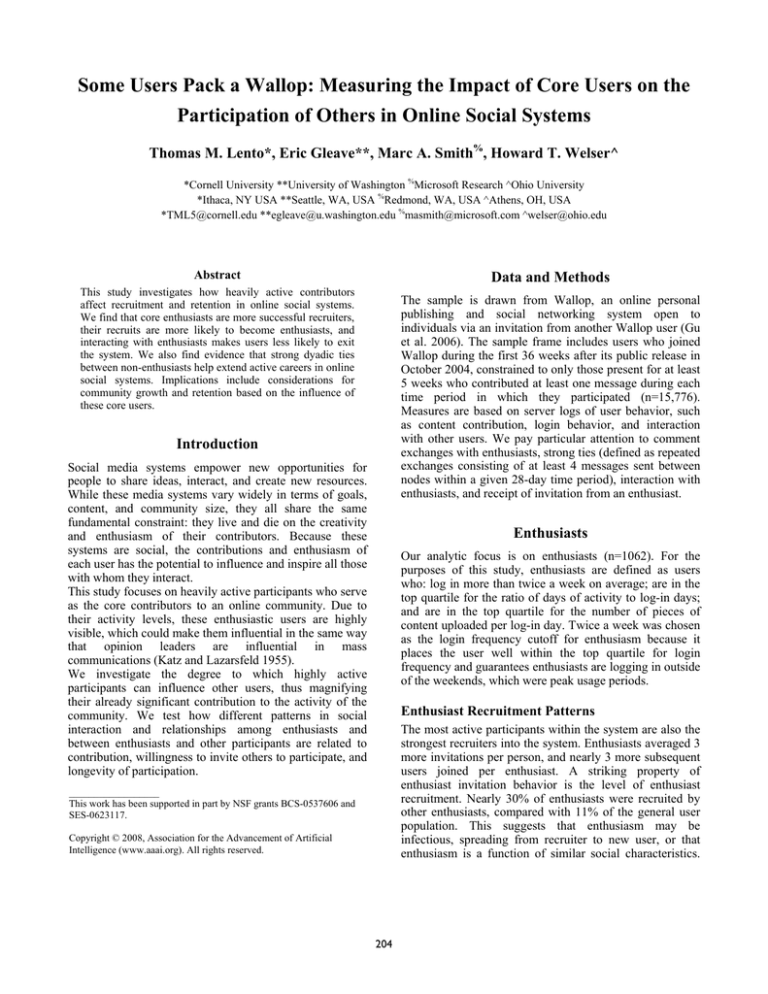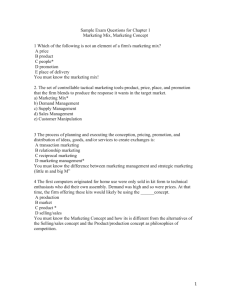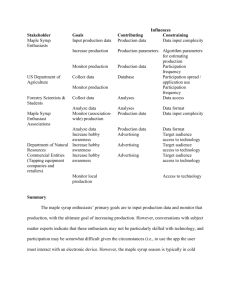
Some Users Pack a Wallop: Measuring the Impact of Core Users on the
Participation of Others in Online Social Systems
Thomas M. Lento*, Eric Gleave**, Marc A. Smith%, Howard T. Welser^
*Cornell University **University of Washington %Microsoft Research ^Ohio University
*Ithaca, NY USA **Seattle, WA, USA %Redmond, WA, USA ^Athens, OH, USA
*TML5@cornell.edu **egleave@u.washington.edu %masmith@microsoft.com ^welser@ohio.edu
Abstract
Data and Methods
This study investigates how heavily active contributors
affect recruitment and retention in online social systems.
We find that core enthusiasts are more successful recruiters,
their recruits are more likely to become enthusiasts, and
interacting with enthusiasts makes users less likely to exit
the system. We also find evidence that strong dyadic ties
between non-enthusiasts help extend active careers in online
social systems. Implications include considerations for
community growth and retention based on the influence of
these core users.
The sample is drawn from Wallop, an online personal
publishing and social networking system open to
individuals via an invitation from another Wallop user (Gu
et al. 2006). The sample frame includes users who joined
Wallop during the first 36 weeks after its public release in
October 2004, constrained to only those present for at least
5 weeks who contributed at least one message during each
time period in which they participated (n=15,776).
Measures are based on server logs of user behavior, such
as content contribution, login behavior, and interaction
with other users. We pay particular attention to comment
exchanges with enthusiasts, strong ties (defined as repeated
exchanges consisting of at least 4 messages sent between
nodes within a given 28-day time period), interaction with
enthusiasts, and receipt of invitation from an enthusiast.
Introduction
Social media systems empower new opportunities for
people to share ideas, interact, and create new resources.
While these media systems vary widely in terms of goals,
content, and community size, they all share the same
fundamental constraint: they live and die on the creativity
and enthusiasm of their contributors. Because these
systems are social, the contributions and enthusiasm of
each user has the potential to influence and inspire all those
with whom they interact.
This study focuses on heavily active participants who serve
as the core contributors to an online community. Due to
their activity levels, these enthusiastic users are highly
visible, which could make them influential in the same way
that opinion leaders are influential in mass
communications (Katz and Lazarsfeld 1955).
We investigate the degree to which highly active
participants can influence other users, thus magnifying
their already significant contribution to the activity of the
community. We test how different patterns in social
interaction and relationships among enthusiasts and
between enthusiasts and other participants are related to
contribution, willingness to invite others to participate, and
longevity of participation.
Enthusiasts
Our analytic focus is on enthusiasts (n=1062). For the
purposes of this study, enthusiasts are defined as users
who: log in more than twice a week on average; are in the
top quartile for the ratio of days of activity to log-in days;
and are in the top quartile for the number of pieces of
content uploaded per log-in day. Twice a week was chosen
as the login frequency cutoff for enthusiasm because it
places the user well within the top quartile for login
frequency and guarantees enthusiasts are logging in outside
of the weekends, which were peak usage periods.
Enthusiast Recruitment Patterns
The most active participants within the system are also the
strongest recruiters into the system. Enthusiasts averaged 3
more invitations per person, and nearly 3 more subsequent
users joined per enthusiast. A striking property of
enthusiast invitation behavior is the level of enthusiast
recruitment. Nearly 30% of enthusiasts were recruited by
other enthusiasts, compared with 11% of the general user
population. This suggests that enthusiasm may be
infectious, spreading from recruiter to new user, or that
enthusiasm is a function of similar social characteristics.
__________________
This work has been supported in part by NSF grants BCS-0537606 and
SES-0623117.
Copyright © 2008, Association for the Advancement of Artificial
Intelligence (www.aaai.org). All rights reserved.
204
This also suggests that the core user population has the
potential to renew itself and expand over time.
minimally significant for the enthusiast population. Given
the similarities in the magnitude of the effect across
groups, this difference may be a result of the larger group
size of the non-enthusiast population. It’s also possible that
this result is a function of enthusiasts tending to have more
strong ties to other enthusiasts.
Core User Influence
Do ties to enthusiasts affect retention in social media
systems? Table 1 shows discrete time analysis coefficients
expressed as odds ratios for a model predicting departure
from Wallop. Values less than one indicate that a unit
change in the variable reduces the probability of a user
exiting the system, while values greater than one indicate
an increase in probability of exit. The model uses a binary
variable for departure within a given 28 day period as the
dependent variable. Invitation and interaction ties to
enthusiasts are the key predictors, and controls for other
types of social ties and activity levels are also included.
Table 1 highlights the effects of the most interesting
control variables in addition to the key predictors.
NonEnthusiasts
Enthusiasts
Variable
Login Days (log)
Activity Days (log)
In-Degree (log)
Estimate
0.58***
0.73***
0.96
Estimate
0.45**
0.88
1.24
Intense Ties (log)
Invited By Enthusiast
Enthusiast Ties (log)
0.74***
0.79***
0.90*
0.77*
0.67***
0.74**
*p < 0.05 **p < 0.01
***p < 0.001
Intercept = 31.3
Discussion
Connections to other enthusiasts, particularly through
receiving an invitation, are generally good predictors of
continued participation. The interesting dichotomy that
arises out of the data is the distinction between enthusiasts
and non-enthusiasts. Essentially, an enthusiast is likely to
remain active in the system if she has been logging in
during the prior time period and particularly if she is
connected to other enthusiasts. Non-enthusiasts are likely
to remain active in the system if they are heavily active in
terms of both content contribution and login behavior,
especially if they have strong ties to other users. Their
probability of remaining active is not as closely related to
connections to enthusiasts, suggesting that other users are
not affected as strongly by the amount of their neighbors’
activity. Rather, they are more strongly affected by activity
directed at them. Enthusiasts, then, are the core users who
will remain active so long as there are others around them
who are similarly enthusiastic. Non-enthusiasts require a
more direct social relationship: having enthusiastic
neighbors is often not enough to encourage continued
participation.
All of these results suggest that the enthusiasts act as a core
contributing component to the social media system. They
are visible, produce a great deal of content, and, crucially,
contribute indirectly by helping attract and encourage other
users. There are two general implications for further
research and for consideration in the design and
management of online social systems. First, a key to
growing community may be cultivating enthusiasts
because of their role in recruitment and in retention of
other enthusiasts. Second, a key to retaining rank and file
community members may be mechanisms that help foster
intense dyadic ties between members. Testing the
generality and strength of these possible affects is a
promising direction for future research.
Intercept = 10.98
Table 1: Odds ratios of exit as a function of selected behavioral
and social relationship variables.
The data has been split into two subsets – the enthusiast
population and the rest of the user population. Controls for
activity, measured both as login and content contribution
days, are included as a means of accounting for a possible
tendency for an active user to remain active.
Regardless of whether a user is an enthusiast or not,
invitation by an enthusiast is clearly associated with
continued participation. Connections to other enthusiasts
have a less consistent effect on subsequent participation.
These connections do reduce the probability that
enthusiasts and non-enthusiasts alike will exit the system;
however the magnitude of the effect for non-enthusiasts is
quite small and barely significant. It appears that
enthusiasts are more strongly affected by ties to other
enthusiasts.
Other types of social ties have varying effects on a user’s
propensity to remain active in the system. Interestingly, indegree, a measure of the social attention received by
participants does not predict retention. Intense ties, though,
do have a reasonably clear negative effect on a user’s
subsequent decision to leave Wallop, but the effect is only
References
Gu, L.; Johns, P.; Lento, T. M.; and Smith M. A. 2006.
How Do Blog Gardens Grow? Language Community
Correlates with Network Diffusion and Adoption of
Blogging Systems. In Proceedings of the AAAI Symposium
on Computational Approaches to Analyzing Weblogs, 4754. Menlo Park, Calif.: AAAI Press.
Katz, E. and Lazarsfeld P. 1955. Personal Influence: The
Part Played by People in the Flow of Mass
Communications. Glencoe, IL: The Free Press.
205






